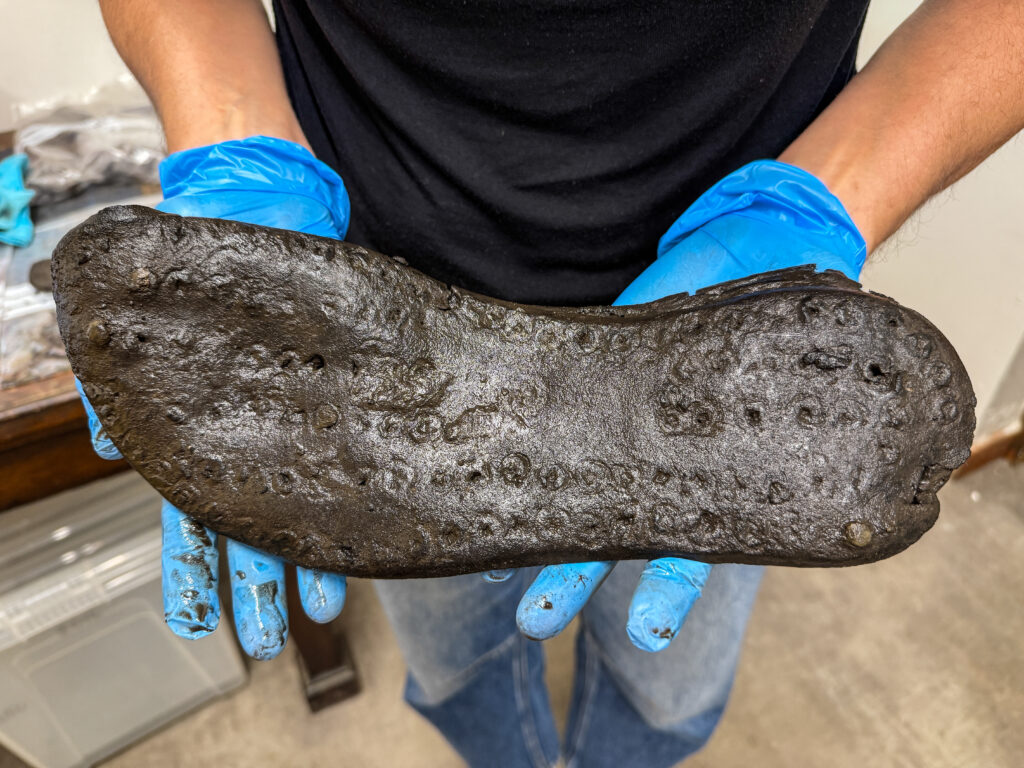Discovery of ancient Roman shoes at Magna Fort leaves a very big impression.
Press release 2nd July 2025
With a collection of around 5,000 ancient shoes uncovered at Roman Vindolanda, the Vindolanda Charitable Trust has gained an amazing insight into the men, women and children who occupied this northern outpost from these very personal items of clothing. The collection includes tiny baby booties, elaborate summer sandals and marching boots. These ancient artefacts captivate the imagination about the sort of people who wore them nearly 2,000 years ago.
The Trust’s excavation at Magna Roman Fort, a significant five-year project funded with support from The National Lottery Heritage Fund, is now adding to that tally. This year the Trust’s archaeologists, supported by teams of volunteers from across the world, have been excavating the northern defensive ditches of the Fort. When the semi-anaerobic low oxygen deposits within the ditches were reached, the first of 32 shoes were uncovered.
It soon became apparent that some of these shoes were very large. The first exceptionally large shoe was reported in the team’s Magna Dig Diary on 21st May. At 32cm (UK size 13/14) the shoe sole attracted a lot of attention, its length ranking it as one of the largest in the Trust’s collection. As news spread of this giant single shoe, the team continued to discover more ancient shoes, several more of them being of an exceptional size. Eight shoes from Magna are now recorded as 30cm or over in length and this includes one which holds the current record for being the Trust’s largest shoe at 32.6cm long. From the shoes uncovered to date at Magna 25% are classed as xx-large (30cm+). In comparison, of the shoes uncovered at Vindolanda, and of which the size can be determined, only 0.4% of shoes are in the same category, with the average shoe size being a smaller 24-26cm in length.

Dr Elizabeth Greene, Associate Professor at the University of Western Ontario and Vindolanda’s shoe specialist, has seen and measured every shoe in the Vindolanda collection. Greene commented, “I think there is something very different going on here at Magna, even from this small sample uncovered it is clear that these shoes are much larger on average than most of the Vindolanda collection”. Dr Greene noted that “although we are comparing this new Magna collection which has not yet gone through the conservation process with the Vindolanda shoes that have, even taking into account a maximum shrinkage of up to 1cm/10mm, it still means these shoes are very large indeed.”
Every shoe in the Vindolanda Trust’s collection is unique, each one giving us an immediate connection with the person who wore it. In addition to the extra-large shoes, the Magna collection includes a range of other sizes, including those belonging to children.
Rachel Frame, Senior Archaeologist at the Magna Project commented: “Organic finds like this are some of the most precious to come from our sites, which capture the imagination of visitors and volunteers alike, but they are also the most at risk from our changing climate. We are grateful to have the support from The National Lottery Heritage Fund, made possible by National Lottery players, who have enabled the Magna project to be realised – there is much more to discover about the people who lived at Magna and to understand about the impact climate change is having on this hugely important historical resource.”
Dr Andrew Birley, the Trust’s CEO and Director of Excavations, added “this really shows us what is at risk if climate change continues to rob us of such vital information. It reminds us that not every population was the same, that wide variations between the regiments and people who served along Hadrian’s Wall, could be cultural and physical. Without artefacts like these wonderful shoes from Magna and Vindolanda, it would be almost impossible to know information like this. We can only celebrate and marvel at the diversity and differences of these people if we can still see them in the archaeological data we gather today”.
~Ends~
All images © The Vindolanda Trust
Press enquiries please contact sonyagalloway@vindolanda.com
Notes to editors.
About the Magna Project
Magna, a unique Roman fort on Hadrian’s Wall, under the care of the Vindolanda Trust, holds some of the keys to understanding the biggest questions about the people of the Roman frontier. Magna has it all and includes half a milecastle, part of Hadrian’s Wall, the Vallum ditch, a large town, rubbish dumps and pits, cemeteries and the fort itself. It’s the junction point between three Roman roads, the Military Way, the Stanegate and the Maiden Way. The site covers an area larger than Vindolanda and has the same preservation layers of organic remains and it is now under threat from climate change.
The Magna project is a five-year research project which commenced in 2023. It will examine three areas of the site, from north to south, building up a profile of the way the land has been used from ancient to modern times. It combines archaeological investigation with non-intrusive survey, and it builds and improves on the previous geoarchaeological investigation work that has taken place. The legacy of the project will be an informed management plan for Magna which provides the Vindolanda Trust with the knowledge that it requires to help preserve this irreplaceable landscape for years to come.
www.romanarmymuseum.com / www.vindolanda.com
Follow @VindolandaTrust on X / Facebook / Instagram and YouTube
About The National Lottery Heritage Fund
Our vision is for heritage to be valued, cared for and sustained for everyone, now and in the future. That’s why as the largest funder for the UK’s heritage we are dedicated to supporting projects that connect people and communities to heritage, as set out in our strategic plan, Heritage 2033. Heritage can be anything from the past that people value and want to pass on to future generations. We believe in the power of heritage to ignite the imagination, offer joy and inspiration, and to build pride in place and connection to the past.
Over the next 10 years, we aim to invest £3.6billion raised for good causes by National Lottery players to make a decisive difference for people, places and communities.

